Anomaly Detection in Google Analytics Intelligence
We’ve had ‘Custom Alerts’ in Google Analytics for a very long time. They used to look like this:
They recently got an facelift and now look nicer, but the data is still the same:
I’ve used these alerts for years to help me detect changes in traffic patterns as they occur (by sending an email alert) rather than at a later point during analysis. They still serve this purpose well. But when it comes to understanding what is driving an anomaly, or even detecting it and it’s degree without previously setting up an alert, the new Anomaly Detection features in Google Analytics Intelligence really shine.
Anomaly Detection in Google Analytics Intelligence helps us answer a very important question (we may not have even known we had): “What are the statistically significant changes in the metrics & dimension slices I care about?”
It does this via a 4 part formula:
- Step 1: Collect enough background data to analyze a pattern and develop a forecast. It requires the past 90 days of data for a daily anomaly or the last 32 weeks of data for a weekly anomaly
- Step 2: Use time-series forecasting to predict the value for the current day
- Step 3: Run a significance test on the forecasted value vs the actual value. Note that thresholds for the forecasted bounds will vary based on the size of the profile’s data and the metric in question
- Step 4: If the actual value falls outside of the forecasted bounds, then classify it as anomaly and provide meaningful data showing what led to the anomaly.
Let’s look at a real example of this in action on my own blog. In the Intelligence pane on the right hand side of my GA UI, I noticed I had a couple of anomalies presented. When I clicked on the cards they expanded to show the anomalies in detail.
The first showed that GA Intelligence had detected an anomaly for pageviews week over week – that my PVs were higher from week to week. It even tells me the forecasted bounds it was expecting to see, and classifies my actual data as an anomaly outside these bounds. When I scroll down, I’m given more information about the anomaly – that it’s changed by +86% compared to the prior week.
When I click ‘Explore this change’ the card expands further to show what might be leading to this anomaly.
Now I can see the exact segments of traffic causing the increase. What I notice is that there is a large spike in 2 main categories: Direct traffic with a landing page of /new-data-retention-policies-in-google-analytics/ and Social traffic from Facebook.
These spikes both makes sense to me, because I know something that GA Intelligence does not: the May 25th Data Retention policy changes were fast approaching and I along with many others were widely sharing a post I wrote breaking down and explaining the changes. I shared that post on Twitter and Facebook, but I also know that it was shared with a lot of other people via friends and industry associates on those channels as well. While I had added UTM parameters to track the referrals, others who shared the post likely did not, and it’s those shares that are leading to direct and facebook traffic that is registering as an anomaly, since this is outside of my normal site traffic patterns.
One last piece of the anomaly card is a button that says ‘Go to report’. When I click it, I am taken to the full GA report showing a week over week comparison of pageviews, and here I can see exactly how dramatic the jump was, especially in comparison to all of my other pages data.
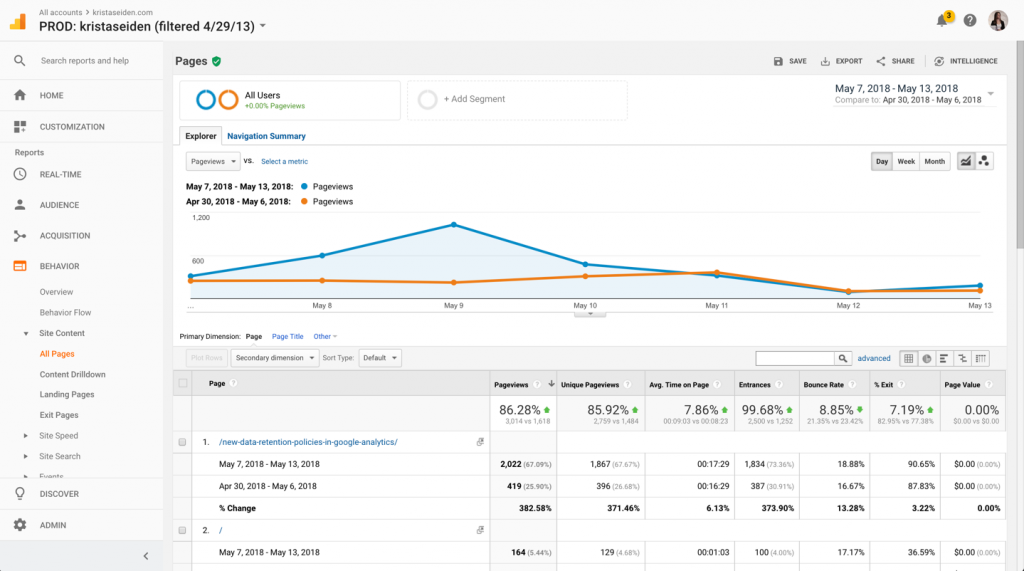
See, you do still need an analyst to interpret some of this stuff 😉
Here are screenshots of one more anomaly that GA Intelligence was alerting me of. It’s actually quite similar to the last, but instead of focusing on pageviews, it’s focusing on Users, which are also up significantly due to the same reasoning I mentioned above.
As you can see, there is a lot of value add that the new anomaly detection features in Google Analytics Intelligence can add to your day to day analysis. Intelligence easily points out trends or anomalies for you to dig into further, based on what you know about your data and your business.
Over the past few years, I’ve had the special privilege of working closely with our Intelligence team as they’ve developed what we’re looking at today. I remember many early working sessions where we would manually come up with the types of anomalies people would want to be made aware of (such as a Week over Week change in Users or Pageviews), and it’s awesome to see how those ideas have manifested themselves in product. I can’t wait to see where we take this next! (ok, maybe I have some idea of where it’s going, but you’ll have to stay tuned to find out!)
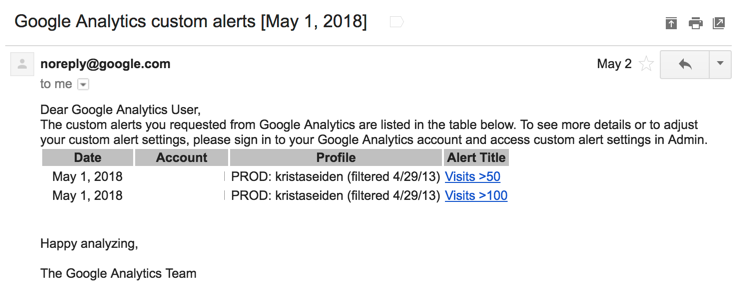
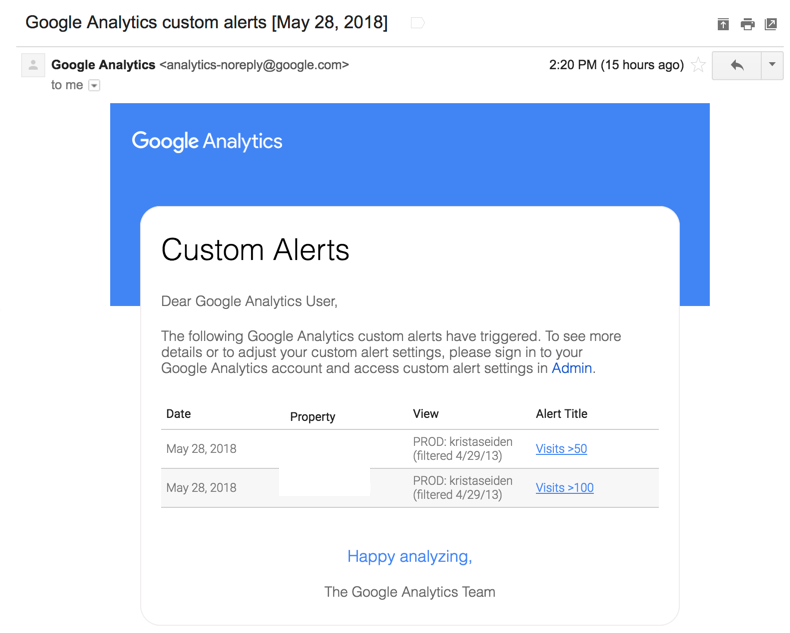
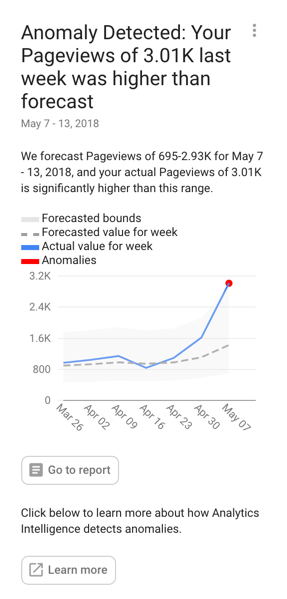
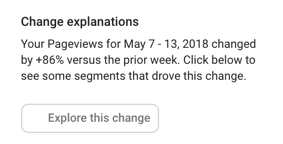
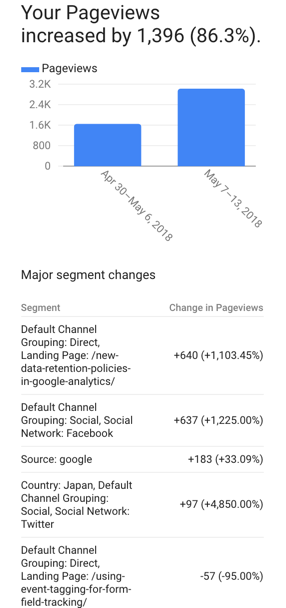
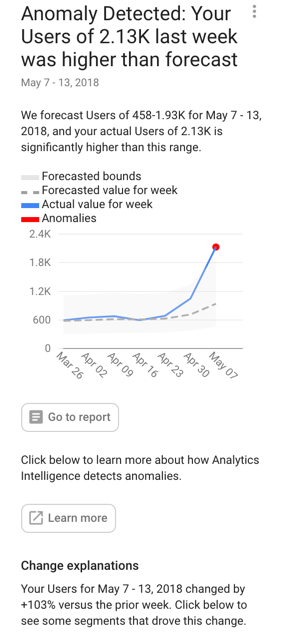
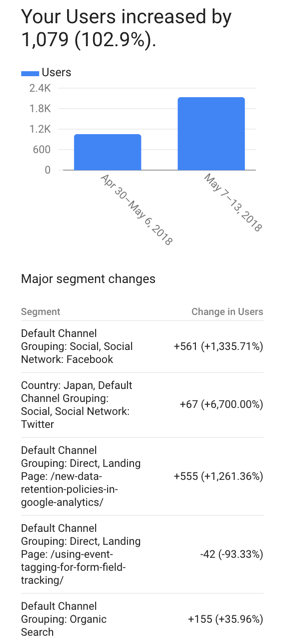
Victor
Anomaly detection is a really cool feature that Google Analytics Intelligence offers. We constantly use is when writing monthly reports for our clients, to see if somehow we missed an important change / event in data that we analyze.
Chris Mallotte
That’s a bit difficult – Millimetric sorted that out – it scales your data to find out what’s normal, eliminating false positives. http://www.millimetric.ai
Ezequiel
Thats super helpful! Is there a way to schedule or check anomaly detection for Custom Reports?
Krista
Not yet, but thanks for sharing your interest in that feature!
Jeremy
I notice that in eCommerce we get an anomaly detection alert when an item goes on sale and its detail page spikes. Is there any way to help Google get smarter so these false positives can be excluded?
Krista
The team is definitely working on being smarter for all sorts of anomalies!
Pingback: #82: PWA y el inicio de las vacaciones 🌴 • Recopilación de enlaces en Oriol Farré
darko
Can a site be punished for an anomaly? It looks like it just happened to my site. I got message: “For this Page, we forecast Pageviews of 92.5–1.8K for Oct 2, 2018, and your actual Pageviews of 2.14K is higher than this range.” and I ignored it. Next day that page dropped from the middle of the first Google search page to the 5th page. My site is new (6 months old) with constantly growing traffic. No traffic buying, bots or any traffic manipulation.
Krista
The Google Analytics anomaly detection (and GA in general) are completely separate and unrelated to SERP rankings – the two sides of the business do not share data and have no influence over each other, so whatever caused the drop in SERP ranking, it wasn’t your Google Analytics report 😉
Pingback: Digital Debrief – Analyzing Reports in the new App + Web Property